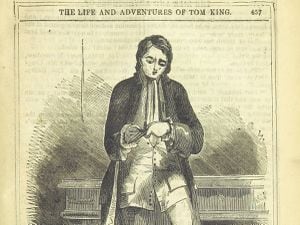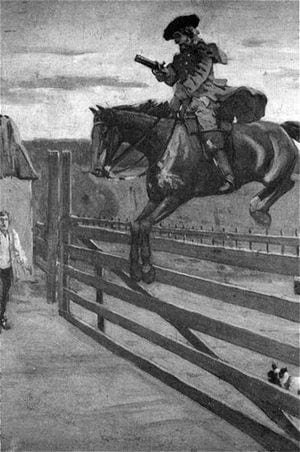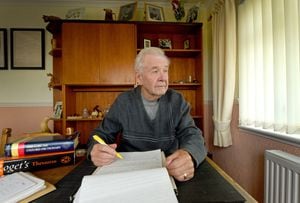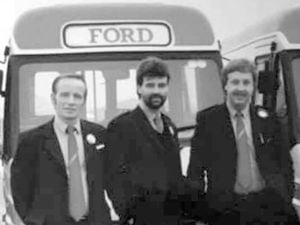The story of the man who led Dick Turpin astray
With hindsight, Matthew 'Tom' King was not the most successful careers adviser.

When he persuaded petty thief Dick Turpin to step up a league and join the big time, things didn't exactly work out quite as he would have planned. Of course Turpin was famously hanged in York at the age of 33 after stealing a horse. But King fared even worse, being accidentally killed by his protege during a bungled robbery.
Retired journalist Lawrence McGowan has been researching the life of Turpin's lesser-known sidekick after joining a history group run by Staffordshire Council.
Turpin was born in 1705 and became an apprentice butcher before he turned to theft and joined a gang, the Gregory Gang, in Essex. At first his butchery skills came in useful when it came to stealing cattle, but he also started committing burglary, gradually becoming increasingly violent as his reign of terror grew.
While many of the legends surrounding Turpin's career paint the picture of a glamorous, romantic outlaw, the truth was usually much less palatable. With gang leader Gregory, he robbed a farmhouse and poured boiling water over the owner, an elderly man, and also raped a woman there. His first murder was of a man named Tom Morris, a servant who recognised him from a robbery and attempted to capture him.
But it was his meeting with Tom King that secured his place in folklore.
According to The Newgate Calendar, published about 40 years after the death of King, their first encounter occurred when "Turpin, seeing him well mounted and appearing like a gentleman, thought that was the time to recruit his pockets", and tried to rob him.
But it seems that far from holding his impudence against him, King decided to join forces.
According to legend, the pair hid out in a cave in Epping Forest and pursued a successful partnership. Their first joint crime was to steal a race horse called White Stockings or Whitestocking,
"It is widely held that it was Tom who encouraged Turpin to abandon petty theft and embark on a career of highway robbery," says Lawrence, 80, who lives in the Huntington area of Cannock.
While there have also been conflicting reports suggesting that King may have been born at the Irish Harp pub near Aldridge, Lawrence says he was most likely born a couple of miles down the road in Stonnall in 1712.
"Stonnall was a notorious hideout for footpads and robbers located south-west of Lichfield on the Chester Road," says Lawrence.
"His childhood home, Wordsley House, once operated as the Welsh Harp public house and a stopping place for coaches.
"The remains of the coach house are now in use as a barn. Local rumour has it that a tunnel tall and wide enough to accommodate a rider on horseback linked the property with the nearby manor house."


But King’s infamy, which by this time had given him a nationwide notoriety, came to an untimely end in May 1737, when one of their robberies went wrong.
"Turpin fired a shot that missed its target and fatally wounded his partner," says Lawrence. King was taken to New Prison in Middlesex, where he was tended to by two surgeons, but died on May 19. He was just 25 years old, and bequeathed all his belongings to his wife Elizabeth.
He adds that the secluded main roads of Staffordshire provided rich pickings for highwaymen during the 17th and 18th centuries, as they targeted carriages, farmers returning from market and even stagecoaches.
"Staffordshire was well-provided with busy commercial routes, the Lichfield Road, Blake Street, Chester Road and Watling Street," he says.
"In Sutton Coldfield, less than a mile from a busy Staffordshire section of the road from London, astute highwaymen set up their headquarters at Muffins Den.
"They would cross the county border, commit a robbery, and return to Warwickshire where the Sheriff of Staffordshire had no authority."
He says the term ‘highwayman’ is thought to have originated after the end of the English Civil War in 1649, when disaffected royalist officers who lacked a skilled trade sought to put their skills with guns and horses to nefarious uses.
Lawrence adds that the road from Cannock to Penkridge was a hunting ground for highwayman Tom ‘Artful’ Arnott.
He was arrested after Granny Brewer, a local busybody, identified his hideout to the police. He was tried at Stafford Assizes and sentenced to be hanged and his remains gibbeted (put on display) at a crossroads near to the scene of his crimes.
His body was buried in an unmarked grave alongside the forested track opposite the Shoal Hill Tavern on the New Penkridge Road. "His bones are rumoured to lie close to where the Old Penkridge Road now terminates at the boundary of Shoal Hill Nature Reserve," says Lawrence.
Another famous Staffordshire highwayman was John Deacon, who evaded capture by dressing as a clergyman.
"Legend has it that Deacon was a Robin Hood type character who robbed the rich but helped the poor," says Lawrence.
"He met his end when he encountered a coach full of Bow Street Runners at Pye Green, Hednesford. He was buried on the spot where he died - allegedly close to the site of a glacial boulder known locally as ‘The Wishing Stone’."
The growth in highway robbery led to the passing of a law in 1692 which offered big rewards for information leading to the capture of highwaymen. In 1773 the reward stood at £200, or £34,700 at today's prices.
While Turpin was famously a butcher by trade, Lawrence says the crime was not the exclusive preserve of working-class men.
"Sometimes whole families were involved," he says.
"Phillip Tysden, consecrated Bishop of Raphoe, an Oxford graduate and doctor of civil law, was among the upper class robbers.
"So was Lady Katherine Ferrers. She is said to have entertained wealthy aristocrats at her home and, after they left, donned male clothing and robbed them on their way home."
He adds that Jerry Abershawe, born in 1773, was the last highwayman to have his remains put on display following his execution in 1795.
"Robert Snooks was the last highwayman in England to be executed for highway robbery," he adds.





